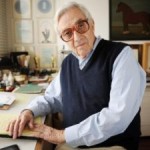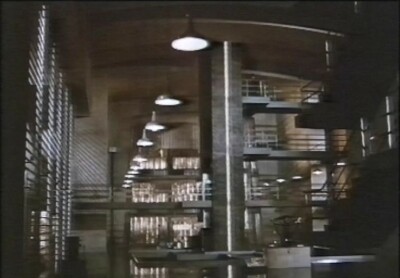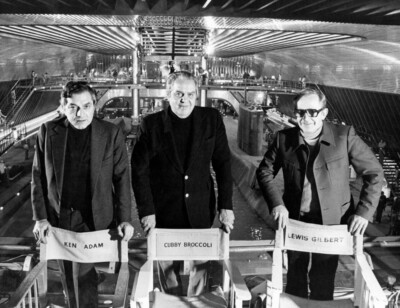 When Sir Ken Adam (1921-2016) passed away a few years ago, he was seen by many film experts and cultural commentators as a ‘designer extraordinaire‘. His influence on the James Bond movies of the 1960s and 1970s was instrumental in giving them a distinctive and highly memorable ‘look’, and his imagination knew no bounds.
When Sir Ken Adam (1921-2016) passed away a few years ago, he was seen by many film experts and cultural commentators as a ‘designer extraordinaire‘. His influence on the James Bond movies of the 1960s and 1970s was instrumental in giving them a distinctive and highly memorable ‘look’, and his imagination knew no bounds.
He was also hugely influential on a new generation of set designers, who drew their inspiration from his iconic work.
His importance to the 007 formula in particular was captured in a statement released on 11th March, 2016, by the Bond producers Michael G. Wilson and Barbara Broccoli, shortly after his death. The EON co-producers had stated back then: ‘The Bond family mourns the passing of our beloved friend Sir Ken Adam who was so responsible for the visual style of the James Bond films from their inception. A genius and a gentleman, he will be deeply missed’.
Indeed, it is no exaggeration to say that the artistic work of production designer Sir Ken gave ample evidence of the major influence he had exerted on both film design and wider architecture during his lifetime.
Interestingly, in 2012, in an act of typical generosity from the former wartime RAF pilot, Sir Ken had donated his entire artistic and design output to the Deutsche Kinemathek, a collection which included over 4,000 drawings, various storyboards, many photographs from movie sets, numerous personal documents, and a large number of design sketches, including his designs for all the work he had carried out on his James Bond movies, up to and including Moonraker (1979). The Deutsche Kinemathek went on to make the Ken Adam collection available via an online inventory in the Summer of 2015, and an exhibition gave the public an excellent foretaste of the wide range of material contained in the collection, which has since become an invaluable resource for both film historians and design scholars.
Sir Ken Adam: A JBIFC Appreciation
Once dubbed the ‘Man with the Midas Touch’ by one UK newspaper, during his lifetime Sir Ken became something of a legend among Bond film aficionados across the globe and, for many years, was arguably one of the British film industry’s pre-eminent production designers. Plenty of other production and set designers regularly pointed to Sir Ken’s exemplary work as inspiring their own designs over the years, while the veteran designer also had a significant fan-base among both mainstream and modernist architects. In 2013, for example, in a special BBC Radio-3 documentary profile of Ken Adam, it was revealed that the award-winning top architect Norman Foster was a big fan of Sir Ken’s work. At one point in the documentary, the former 007 designer was especially stunned to discover that Foster’s design for what had become the new German parliament building had been influenced by the Adam design ‘look’.
Designer Royale
German-born Ken Adam was a refugee from Nazi Germany (his family had fled to Britain in 1934) and he had served as a pilot in the British RAF in World War Two. In a number of interviews, he said he had been struck by the ‘giganticism’ of the homes of the totalitarian dictators, which often reflected their evil and monstrous egos, and Adam said he had tried to capture some of this in his set designs for the Bond villains. He had originally trained to be an architect, but the world of film offered numerous possibilities. Tellingly, Adam once commented that movie set work, while often enormously challenging, remained deeply satisfying when it went well.

And, clearly, it did go extremely well for Adam over the decades. He was nominated for many awards over the years, including for his set designs on the James Bond movies, and also picked up BAFTA Awards for Dr. Strangelove (1964) and The Ipcress File (1965). He also held two Academy Awards: for Barry Lyndon (1975) and The Madness of King George (1994). In 2011, in celebration of his 90th birthday (he had turned 90 in February, 2011), Sir Ken was given a special BAFTA Tribute for his services to film.
Sir Ken Adam gave many interviews about his work over the years, and many of these highlighted his ground-breaking design work on the 007 franchise and on other movies. But Sir Ken always remained very modest about his own contribution to the movie world. When interviewed by The Times in 2011, for example, the London-based newspaper suggested to him that his lush and extravagant sets, such as the volcano rocket base in You Only Live Twice (1967) and the submarine-swallowing supertanker in The Spy Who Loved Me (1977), really defined the mood of the entire 007 series. Sir Ken responded: ‘No, no! It was nice working on the Bonds. They needed someone to come up with bigger and bigger visual designs and backgrounds. And that’s what I did!’
However, as the Deutsche Kinemathek exhibition undoubtedly showed, Sir Ken Adam not only created ever-bigger set designs, but also played an instrumental role in many other aspects of the highly memorable ‘look’ of the 007 franchise, contributing heavily to the smash-hit success of the Bond movies for two decades and, in the process, encouraging a whole new generation of designers to translate their ideas into visual form.
Golden Fingers
Ken Adam spent many hours in his studio working on his drawings and latest designs, and clearly had what you might call golden fingers. As the late Sir Roger Moore observed in his book Bond on Bond in 2012, Adam’s ‘sloping roofs, gigantic sets and wonderful blending of the futuristic and classic was revolutionary’.

In fact, some people were so in awe of what they had seen on the big screen that they could not quite believe that such sets were not real. Sir Roger noted that on Goldfinger, for example (a movie which celebrates its 60th anniversary in 2024), Sir Ken’s ‘fictionalized vision of the interior of Fort Knox caused the American authorities to question their obvious breach of security – even they thought it was real’.
Adam certainly had fans in high places, such as the director Stanley Kubrick (Dr. Strangelove and Barry Lyndon), and other key film industry figures, including his ever-loyal EON boss. Significantly, Bond producer Albert ‘Cubby’ Broccoli also pointed to the Fort Knox set as a highly special moment in the Bond franchise’s design history. In his memoirs, When the Snow Melts (1998), Cubby said that Adam’s concept of what the inside of the Fort Knox depository supposedly looked like ‘was close to genius’.
Cubby had also been bowled over by the huge volcano set for You Only Live Twice (1967), although he also quipped that every time Ken Adam had calculated the financial costs for his latest set design, Cubby nearly had a heart attack! Similarly, when recalling the making of The Spy Who Loved Me (1977), the EON producer said Ken Adam’s set designs ‘were masterly’, the gem being, in his view, the Liparus, villain Karl Stromberg’s supertanker, for which they had to construct at Pinewood Studios what became (at the time) the biggest film stage in the world.
For many Bond fans, Adam’s talents were nowhere more apparent than on Moonraker (1979), his last film for EON. Taking full advantage of another multi-million pound budget (the movie had transferred to France for tax reasons), Adam built some of the largest sets in French film industry history: he came up with some visually stunning rocket-launch sets, for example, while the orbital space-station HQ to which Drax and his crews travel was another design triumph. Moreover, in another example of how Adam could combine authenticity with the futuristic, and working with the close co-operation of NASA, Ken Adam ensured that the space shuttles designed for the movie were as true to life as possible. It was Adam at his best yet again.

Ken Adam with Cubby Broccoli and Lewis Gilbert on the set of the Stromberg supertanker at Pinewood Studios.
